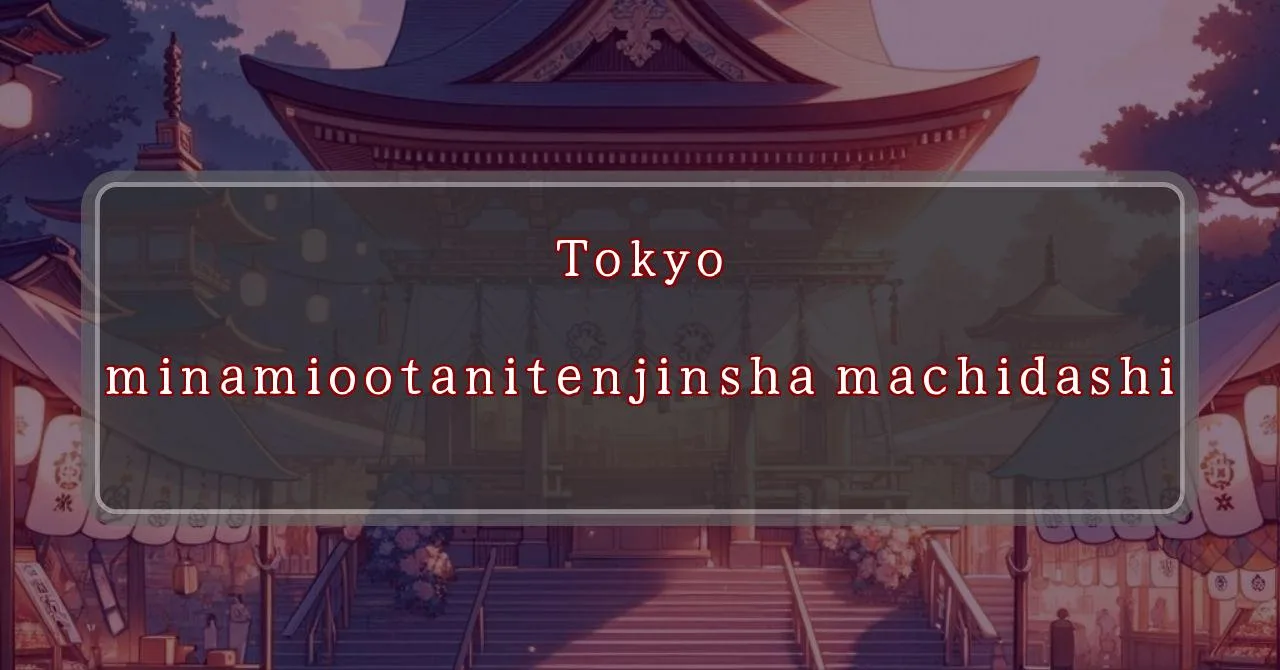Enchanting Shrine Festival in Machida
Basic Information
Here’s an overview of the 2024 Minami-Ooya Tenjinja Machida Festival.
- Address: 451 Minami-Ooya, Machida-shi, Tokyo
- Phone Number: 042-725-3991
- Access: Take the Odakyu Line to Tamagawa Gakuenmae Station, then transfer to the bus bound for Minami-Ooya Danchi and get off at the Jinja-mae bus stop. Alternatively, take the JR Yokohama Line to Machida Station, then transfer to the bus bound for Minami-Ooya Danchi and get off at the Jinja-mae bus stop.
- Festival Days: September 25th (Wednesday), 2024
Main Events and Attractions of the Festival
The Minami-Ooya Tenjinja Festival is a vibrant and lively event that attracts many visitors each year. Here are some of the main events and attractions of the festival:
Mikoshi Procession
One of the highlights of the festival is the mikoshi procession. A mikoshi is a portable shrine that is carried through the streets by a group of people. The mikoshi of Minami-Ooya Tenjinja is particularly large and impressive, and it is carried by a team of over 100 people. The procession is a lively and colorful event, and it is a great opportunity to experience Japanese culture and tradition.
Kagura Performance
Kagura is a traditional Japanese dance that is often performed at festivals and other special events. At the Minami-Ooya Tenjinja Festival, kagura is performed by a group of young women who are dressed in colorful costumes. The dance is graceful and elegant, and it is a beautiful sight to behold.
Food Stalls
No Japanese festival is complete without food stalls! At the Minami-Ooya Tenjinja Festival, there will be a variety of food stalls selling everything from traditional Japanese dishes to more modern fare. You can also find a variety of souvenirs and crafts at the festival.
Fireworks Display
The festival concludes with a spectacular fireworks display. The fireworks are launched from a nearby park, and they light up the night sky with their brilliant colors. The fireworks display is a fitting end to a wonderful festival.
Blessings and Deities
Minami-Ooya Tenkanomitama no Mikoto, and Ooyamagui no Mikoto.
- Sugawara no Tenjin, and he is revered as the god of scholarship and learning.
- Ukanomitama no Mikoto is the goddess of food and agriculture. She is also known as Inari, and she is often worshipped by farmers and businesspeople.
- Ooyamagui no Mikoto is the god of mountains and forests. He is also known as Daimon, and he is worshipped by people who live in mountainous areas.
Origin and History
The origins of Minami-Ooya Tenjinja are unclear, but it is believed to have been founded in the 17th century. The shrine was originally located in a different part of Machida, but it was moved to its current location in 1810.
- 17th century: Minami-Ooya Tenjinja is founded.
- 1810: The shrine is moved to its current location.
- 1945: The shrine is destroyed by fire during World War II.
- 1960: The shrine is rebuilt.
Tips and Notes for Visitors
Here are some tips and notes for visitors to Minami-Ooya Tenjinja:
- Hours: The shrine is open from 9:00 AM to 5:00 PM.
- Admission: Admission to the shrine is free.
- Dress code: There is no specific dress code for visiting the shrine, but it is considered respectful to dress modestly.
- Photography: Photography is permitted inside the shrine, but please be respectful of other visitors.
- Parking: There is a small parking lot available for visitors.
Parking Information
There is a small parking lot available for visitors to Minami-Ooya Tenjinja. The parking lot is located next to the shrine, and it can accommodate about 20 cars. Parking is free of charge.
Popular Stalls and Food Carts in Recent Years
| Type of Stall | Description |
|---|---|
| Takoyaki | A staple at Japanese festivals. Characterized by a crispy outside and a creamy inside. |
| Jaga Butter | A simple yet popular snack of hot potatoes lavishly topped with melted butter. |
| Baby Castella | Small castella cakes, sweet and fluffy treats enjoyed by children and adults alike. |
| Grilled Ayu with Salt | Fresh ayu fish grilled whole with salt, a savory taste of Japanese summer. |
| Shaapin | A unique gourmet item influenced by foreign cuisine, with a chewy skin wrapping the filling. |
| Okonomiyaki | A Japanese grilled dish where you often choose your own ingredients for a personalized flavor. |
| Cotton Candy | A fluffy, sweet snack that’s extremely popular with children. |
| Chocolate Banana | A banana coated in chocolate, a fun and visually appealing dessert. |
| Kushiyaki | Various types of ingredients skewered and grilled, an easy-to-enjoy snack. |
| Yakisoba | Fried noodles mixed with a special sauce, a fast food favorite in Japan. |



